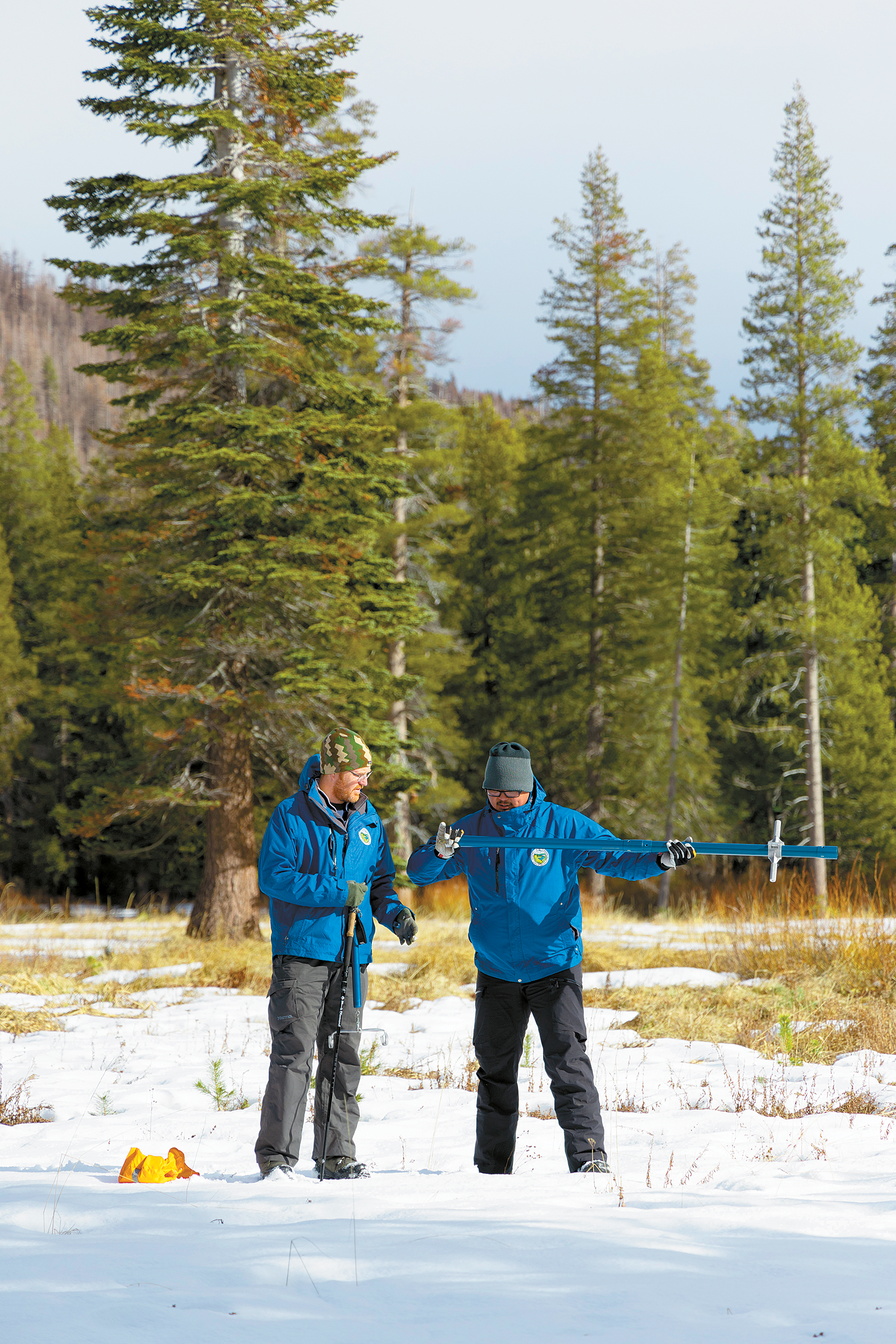Healthy reservoir levels offset scant snowpack depths

Sean de Guzman, right, manager of the California Department of Water Resources Snow Surveys and Water Supply Forecasting Unit, and water resources engineer Anthony Burdock measure snowpack Jan. 2 at Phillips Station in the Sierra Nevada. Statewide, the snowpack, as of Monday, measured 36% of average, with key precipitation months still to come.
Photo/California Department of Water Resources

By Christine Souza
Unlike early 2023, when nonstop atmospheric river storms built a deep Sierra Nevada snowpack, replenished depleted reservoirs and flooded parts of California, snowfall and rain is sharply diminished so far this year. But state water officials say there is plenty of winter left to accumulate more snow and precipitation.
California Department of Water Resources State Climatologist Michael Anderson said accumulation of snowpack has just begun, pointing out that half the state’s annual precipitation typically occurs during December, January and February.
“This period of really wet/really dry was definitely on display last year, but what we’re seeing this year is not quite the strength of either wet or dry, so everything is a little bit subdued,” Anderson said.
In the days since DWR’s first Sierra Nevada snow survey of 2024 last week, storms added more snow, increasing the early January statewide snowpack figure of 25% of average to 36% of average as of Monday. At this time last year, the state’s snowpack measured 117% of average, which is more than half of the average yearly total.
“It’s really still too early to determine what kind of year we’ll have in terms of wet or dry,” said DWR Snow Surveys Manager Sean de Guzman. “There can be so many things that happen with our storm systems between now and April, when we should see our peak snowpack.”
Recorded on April 1, the state’s peak snowpack data is used in modeling by DWR to determine the amount of runoff the state can anticipate when snow melts in the spring and summer. The snowpack supplies about 30% of the state’s water needs. “What we’re interested in is how much water is in the snowpack,” de Guzman said.
Glenn County farmer Mike Vereschagin, who farms almonds and prunes in Orland, said he remains optimistic about the coming water year, especially with reservoirs at or above their historical capacity due to snow and water accumulated in 2023.DWR reported that statewide reservoir storage is about 115% of average.
“As far as water supply this year, it is way too early to know what our allocation is going to be, but the positive thing is our water comes from Shasta Reservoir, and the reservoir level is above normal,” said Vereschagin, who serves as board president of the Orland-Artois Water District, which received 100% of its contracted water supplies last year. “Compared to two years ago (during the drought), it is a much better situation. As long as they conserve the supply and don’t just release it out of the dam, there should be enough water for a decent allocation.”
A north-of-delta water contractor of the federal Central Valley Project, Orland-Artois Water District receives 53,000 acre-feet of water annually and serves about 29,000 acres. As of Monday, Shasta Reservoir—the largest CVP reservoir—was at 69% of its 4.5 million-acre-foot capacity, or 115% of average, according to DWR.
Most other reservoirs remain at above-average levels. Lake Oroville, the principal reservoir for the State Water Project, was at 69% of its 3.5 million-acre-foot capacity, or 128% of average. San Luis Reservoir, a south-of-delta reservoir shared by the CVP and SWP, stood at 57% of its 2 million-acre-foot capacity—88% of average.
Fresno County farmer Justin Diener of Red Rock Ranch in Five Points, which grows grain, garlic, tomatoes, cotton and almonds, said the water outlook is positive.
“This year, things look a lot better just on a relative basis because of the amount of water that is in storage in the reservoirs,” said Diener, who is on the board of directors for Westlands Water District, a CVP water contractor. “It’s not raining as much as it did last year, but our reservoir storage is in a much better position.”
The CVP portion of available water stored in San Luis Reservoir, a joint state-federal reservoir, he said, is about 80%.
“For us on the west side, when there’s a strong, wet year, the following year we usually have a good water year, plus a moderate or average 40% to 60% allocation,” Diener said. “We’re in a good a position.”
With water in San Luis Reservoir, Diener said he was able to prepare for the growing season.
“We have kept the same crop setup, where we’re growing quite a bit of grain and garlic because we will have water to some degree,” he said. “We don’t (yet) know how much water we’ll have into May and June, but it won’t require as much to finish those crops.”
Even with a 100% water allocation last year, Westlands Water District farmers fallowed 198,700 acres, or about 35% of total acreage, according to the district’s 2023 crop report. The fallowed acres, Diener said, is likely due to timing of the allocation announcement. Since precipitation came late last year, many farmers did not have the opportunity to line up as many crop contracts by the time the full allocation was announced in late April.
“In our area, a lot of the preparatory work and obtaining of contracts to grow crops takes place in the fall,” he said.
Looking ahead, state water officials announced last week that extreme weather events highlight the need for Californians to prepare for flood risk. DWR noted it is working with emergency response partners and reservoir operators to prepare flood infrastructure.
As part of this effort, farmers hope to take advantage of flood flows for groundwater recharge, such as in 2023, to replenish aquifers, which are required to reach sustainability by the 2040s under the state’s Sustainable Groundwater Management Act. Vereschagin said last spring and summer, growers in his district took advantage of available floodwater for groundwater projects.
“Our records show that we have made a difference,” Vereschagin said. “We did the recharge, and hopefully we can continue in the future because we have a long way to go to get back to historical levels.”
Similarly, Westlands Water District “implemented several programs to encourage growers to recharge groundwater, both for the benefit of the collective district and of individual growers,” Diener said. The district recharged more than 200,000 acre-feet since last March, he added.
“Hopefully, we’ll get 275,000 acre-feet to 300,000 acre-feet (of recharge). If we do that, going forward on our SGMA plan, we’ll have multiple years of sustainability in terms of averaging out the years we pump a lot and years we don’t pump or pump a moderate amount,” Diener said. “This is a real tool that we’ve been successful in using to move our groundwater basin more quickly towards sustainability.”
The next DWR survey at Philips Station is scheduled for Feb. 4.
(Christine Souza is an assistant editor of Ag Alert. She may be contacted at csouza@cfbf.com.)




